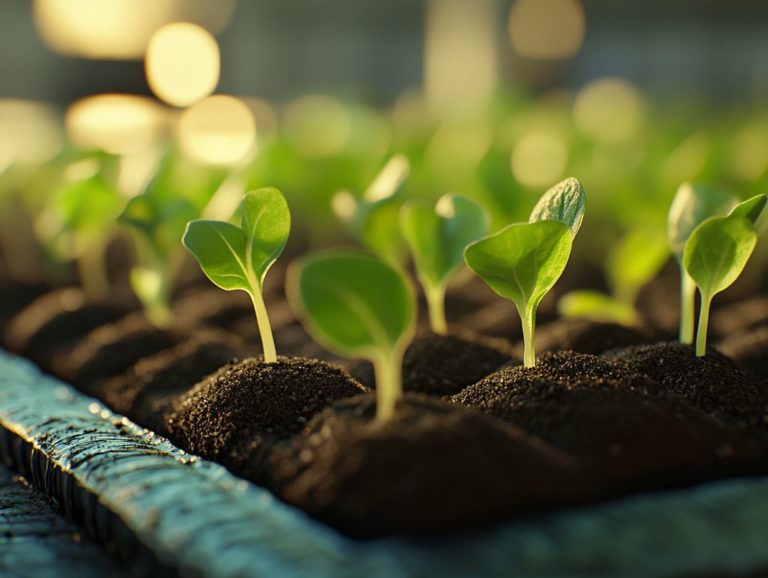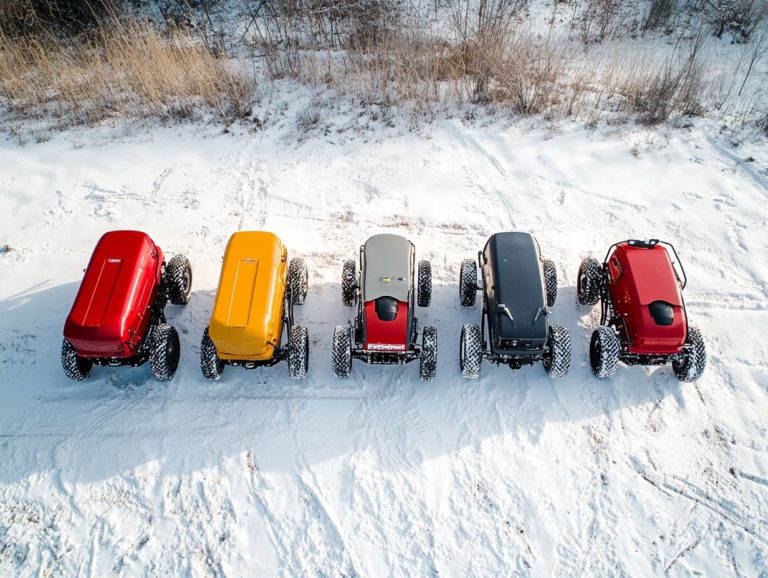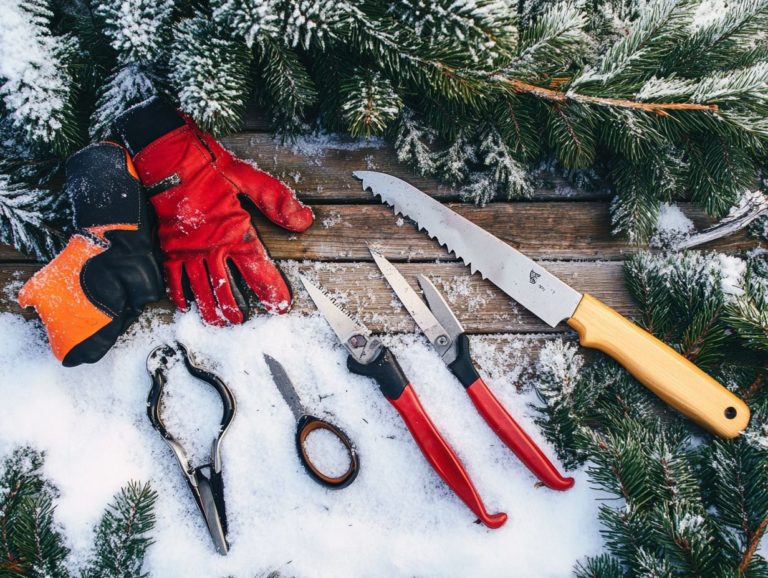Top 10 Cold-Weather Irrigation Systems
As winter approaches, it s essential for you to ensure your irrigation system is ready to tackle the colder temperatures, safeguarding the health of your landscapes and optimizing water usage.
This article delves into the top 10 cold-weather irrigation systems designed to endure chilly conditions while providing the necessary moisture for your plants.
From drip and sprinkler systems to cutting-edge subsurface solutions, you ll discover the amazing benefits, types, and crucial maintenance tips that will empower you to make informed decisions.
Whether you re a homeowner or a business owner, you ll uncover valuable insights to enhance your irrigation strategy this season, including the benefits of automatic drain valves and freeze drains for winter protection.
Contents
- Key Takeaways:
- 1. Drip Irrigation Systems
- 2. Sprinkler Systems
- 3. Soaker Hoses
- 4. Micro-Sprinkler Systems
- 5. Oscillating Sprinklers
- 6. Impact Sprinklers
- 7. Rotor Sprinklers
- 8. Center Pivot Irrigation Systems
- 9. Traveling Sprinkler Systems
- 10. Subsurface Irrigation Systems
- What Are Cold-Weather Irrigation Systems and How Do They Work?
- What Are the Benefits of Using Cold-Weather Irrigation Systems?
- What Are the Different Types of Cold-Weather Irrigation Systems?
- How Can a Business Determine the Best Cold-Weather Irrigation System for Their Needs?
- What Are the Maintenance Requirements for Cold-Weather Irrigation Systems?
- What Are the Common Mistakes to Avoid When Using Cold-Weather Irrigation Systems?
- Frequently Asked Questions
- What are the top 10 cold-weather irrigation systems?
- What is the most effective cold-weather irrigation system?
- Can I use a regular sprinkler system in cold weather, or should I consider a more advanced system?
- How do I choose the right cold-weather irrigation system for my garden, considering options like smart irrigation controllers?
- Can I install a cold-weather irrigation system myself, or should I rely on irrigation professionals?
- Are there any eco-friendly cold-weather irrigation systems available, such as drip irrigation and rainwater harvesting systems?
Key Takeaways:
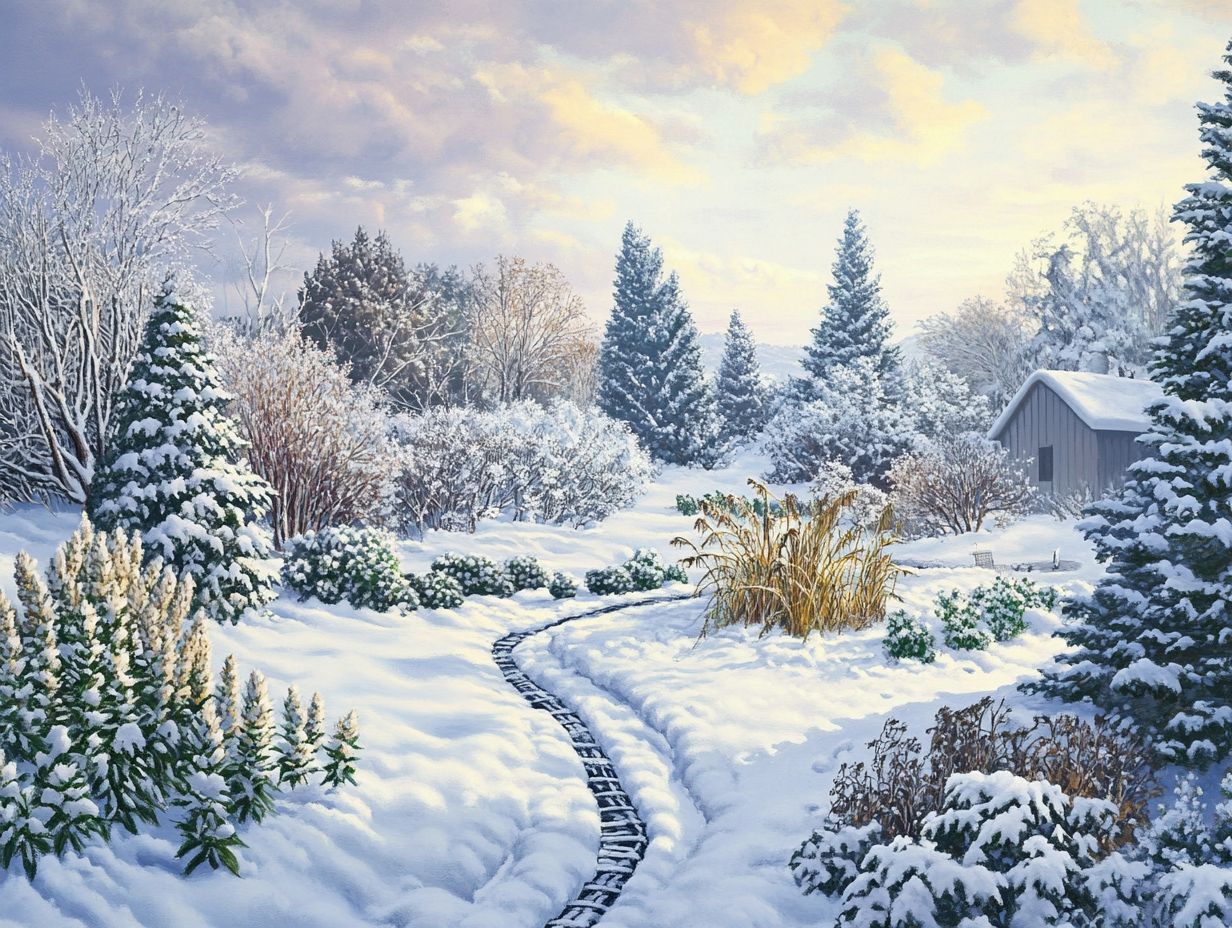
- Drip irrigation systems are a very helpful option for cold weather as they minimize water wastage and protect plants from frost.
- Soaker hoses provide gentle and consistent watering, making them ideal for fragile plants in cold temperatures.
- Micro-sprinkler systems are versatile and can be adjusted to cover a wide area, making them suitable for large gardens in cold climates.
1. Drip Irrigation Systems
Drip irrigation systems are an effective method for optimizing water usage in your gardening and landscaping endeavors. They re designed with efficiency in mind, tailored to suit various soil conditions, making them a critical tool for those looking to elevate their irrigation game while conserving precious water resources.
By employing a network of tubing and emitters (small devices that release water directly to plants), these systems deliver water directly to the roots of your plants, ensuring maximum moisture retention and promoting robust growth.
This targeted approach significantly reduces evaporation and runoff (the water that flows away instead of soaking into the ground), giving you a distinct advantage over traditional sprinkler methods that often squander valuable resources. Drip irrigation is incredibly versatile, adapting seamlessly to different plant types and diverse climates, allowing for precise water application tailored to your needs.
When you integrate it with smart sprinkler timers like the Rachio 3, you gain the ability to effortlessly monitor and adjust your watering schedules through an intuitive app. This harmonious blend not only encourages water conservation but also offers customizable settings that cater to specific hydration requirements, making maintenance simpler and more efficient than ever!
2. Sprinkler Systems
Sprinkler systems are an exceptional solution for outdoor irrigation, allowing you to easily manage different watering areas. Thanks to modern irrigation controllers like the Rachio 3, you gain access to advanced features designed for your convenience.
These systems come in various styles, including drip irrigation, which delivers water directly to the root zone, and rotating sprinklers that provide extensive coverage. The installation process can range from straightforward DIY setups to more intricate professional installations, depending on your landscape’s unique layout and the specific needs of your plants.
Many contemporary systems offer customizable scheduling options, allowing you to set watering durations and frequencies based on weather conditions or seasonal changes. You can also integrate voice assistants like Amazon Alexa and Google Home to manage your watering effortlessly through simple voice commands, making the whole process more efficient and convenient!
Don t wait until it s too late! Prepare your irrigation system for winter now!
3. Soaker Hoses
Soaker hoses are a straightforward yet highly effective element of your irrigation system, crafted to enhance water conservation by delivering moisture directly to the soil.
It s no wonder they re a popular choice for gardening enthusiasts who value simplicity and efficiency in their garden maintenance routines.
These hoses operate by allowing water to seep gently through their porous material, ensuring a consistent supply of moisture to plant roots while minimizing evaporation and runoff.
As a result, you ll experience a significant reduction in water usage compared to traditional overhead sprinklers.
Combining soaker hoses with smart watering systems boosts their effectiveness.
These advanced systems adjust scheduling and water flow based on current weather information and soil moisture levels.
This innovation not only keeps your plants thriving but also gives you more control over your watering routine don t miss out!
4. Micro-Sprinkler Systems
Micro-sprinkler systems harness modern watering systems to deliver precise watering, making them perfect for managing multiple zones while enhancing energy efficiency.
They offer customizable settings tailored to your specific garden needs.
These systems can provide varying amounts of water to different areas, ensuring that your delicate plants receive just the right amount.
This adaptability is particularly beneficial for diverse gardening setups, whether you re cultivating a vegetable patch or maintaining ornamental beds.
When paired with smart watering timers, micro-sprinklers can automatically adjust schedules based on current weather information.
This seamless integration not only fosters sustainable gardening practices but also simplifies maintenance, giving you more time to focus on cultivation rather than manual watering tasks.
5. Oscillating Sprinklers
Oscillating sprinklers make an excellent choice for outdoor irrigation, celebrated for their dependable performance in evenly watering expansive areas.
These versatile devices come with adjustable spray patterns and coverage ranges, making your life easier as a homeowner or gardening enthusiast.
You ll find a variety of models on the market, from manual options to those equipped with timers and smart technology.
By incorporating these sprinklers into a smart watering system, you gain enhanced control, ensuring your plants receive just the right amount of water at optimal times.
This approach not only fosters healthier plant growth but also conserves water an essential consideration for the environmentally conscious gardener.
6. Impact Sprinklers
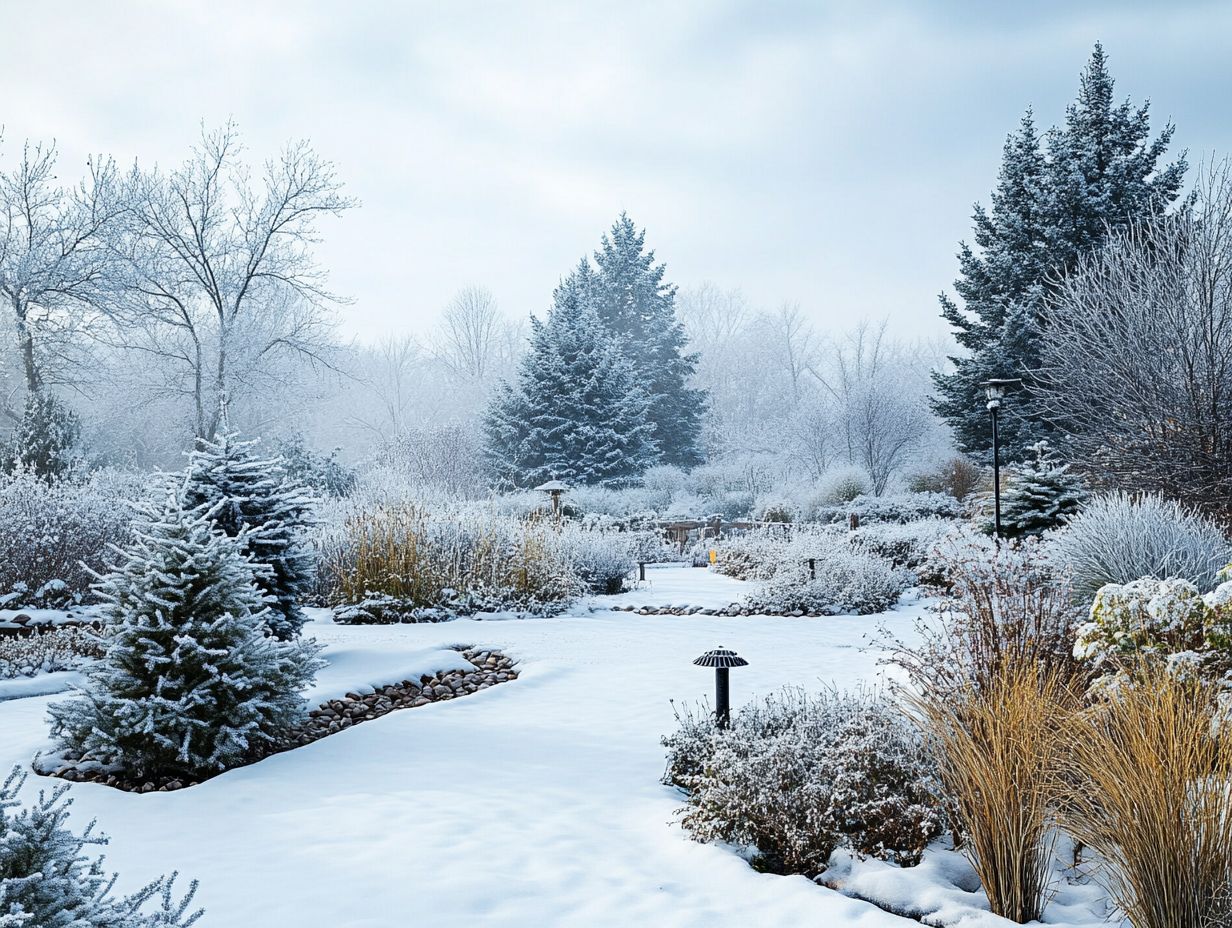
Impact sprinklers are engineered with durable hardware that unleashes powerful water jets, making them your go-to choice for large-scale irrigation.
They ensure optimal watering, even in challenging drainage systems.
These sprinklers operate with a rotating arm that strikes a mechanism, creating a rhythmic, impactful motion that evenly distributes water across vast areas.
Their adjustable settings allow you to customize spray distances and patterns, making them versatile for various applications, from agricultural fields to beautifully landscaped gardens.
One of their standout advantages is the efficiency they provide in conserving water while maximizing coverage, especially in uneven terrains.
When you integrate impact sprinklers with smart watering timers, you elevate their functionality even further.
These advanced systems adjust watering schedules based on current weather information, ensuring that water is applied precisely when and where it s needed most, optimizing both your resources and the results.
7. Rotor Sprinklers
Rotor sprinklers are a vital part of many irrigation systems, crafted to deliver effective water distribution while promoting water conservation. They excel at covering large areas with consistent performance.
These ingenious devices work by using rotating streams of water that evenly spread moisture across expansive spaces. This makes them especially advantageous for larger lawns and agricultural fields. Rotor sprinklers provide significant benefits compared to traditional fixed spray heads, such as better control of water pressure and reduced runoff. This not only leads to healthier plants but also helps lower your irrigation costs.
To maintain optimal performance, regular upkeep is essential. You should routinely check for clogs, ensure proper alignment, and confirm that the water pressure stays within the recommended range. These proactive measures will not only boost sprinkler efficiency but also extend their lifespan, allowing you to enjoy a lush, thriving landscape for years to come.
8. Center Pivot Irrigation Systems
Center pivot irrigation systems offer you a sophisticated solution for large-scale farming, leveraging advanced technology to enhance energy efficiency while automating your watering process. This innovation allows you to maximize crop yields effortlessly.
These systems also feature a series of rotating arms mounted on wheeled towers that glide around a central pivot, delivering water to your crops with remarkable precision. Unlike traditional irrigation methods that can be uneven and wasteful, center pivot systems ensure uniform water distribution, effectively reducing runoff and retaining vital soil moisture. This level of precision conserves resources and cuts down on labor costs, enabling you to manage extensive areas of land with remarkable ease.
By embracing efficient water usage, these systems are game-changers for sustainable farming. They enhance crop resilience against climate fluctuations while safeguarding local ecosystems, making them an invaluable asset for any forward-thinking farmer.
9. Traveling Sprinkler Systems
Traveling sprinkler systems present a distinctive outdoor irrigation solution that embodies both efficiency and flexibility. They are a preferred choice for gardening enthusiasts who value their user-friendly design and compatibility with various irrigation setups.
These systems operate along a preset path, enabling them to cover expansive areas without the hassle of constant manual adjustments a significant advantage compared to traditional stationary systems. By employing a rotating arm and a reliable water source, they deliver consistent moisture to different garden zones, ensuring even coverage.
Not only do traveling sprinklers save you valuable time, but they also minimize water waste, positioning them as an eco-friendly option. When seamlessly integrated into a comprehensive irrigation plan, these systems enhance other watering methods, providing you with a versatile solution that boosts overall plant health and garden productivity.
10. Subsurface Irrigation Systems
Subsurface irrigation systems offer you an innovative solution for water management, operating beneath the soil surface to deliver moisture efficiently while championing water conservation. This reliable performance spans the entire growing season.
This technology employs buried pipes or tubes to channel water directly to the root zone, significantly minimizing evaporation and runoff. Depending on your specific soil conditions be it sandy or clay-heavy subsurface systems can be tailored to enhance water absorption and nutrient availability.
By implementing such systems, you re likely to see healthier crops, as your plants benefit from consistent moisture levels, effectively reducing the risks of over- or under-watering. The automation often integrated into these systems grants you precise control over irrigation schedules, ultimately boosting crop yields and fostering a more sustainable approach to agriculture.
What Are Cold-Weather Irrigation Systems and How Do They Work?
Cold-weather irrigation systems are designed to function well in low temperatures. They feature automatic devices that remove water to prevent freezing and maintain performance all season.
These systems often include smart controllers that adjust watering based on weather forecasts. This ensures efficient water use even in the colder months.
Insulated pipes and heating tape help keep water flowing, protecting essential parts from frost. Such innovations maintain ideal moisture levels for your plants and extend the growing season.
This means you can improve your garden while reducing the risk of costly freeze damage.
What Are the Benefits of Using Cold-Weather Irrigation Systems?
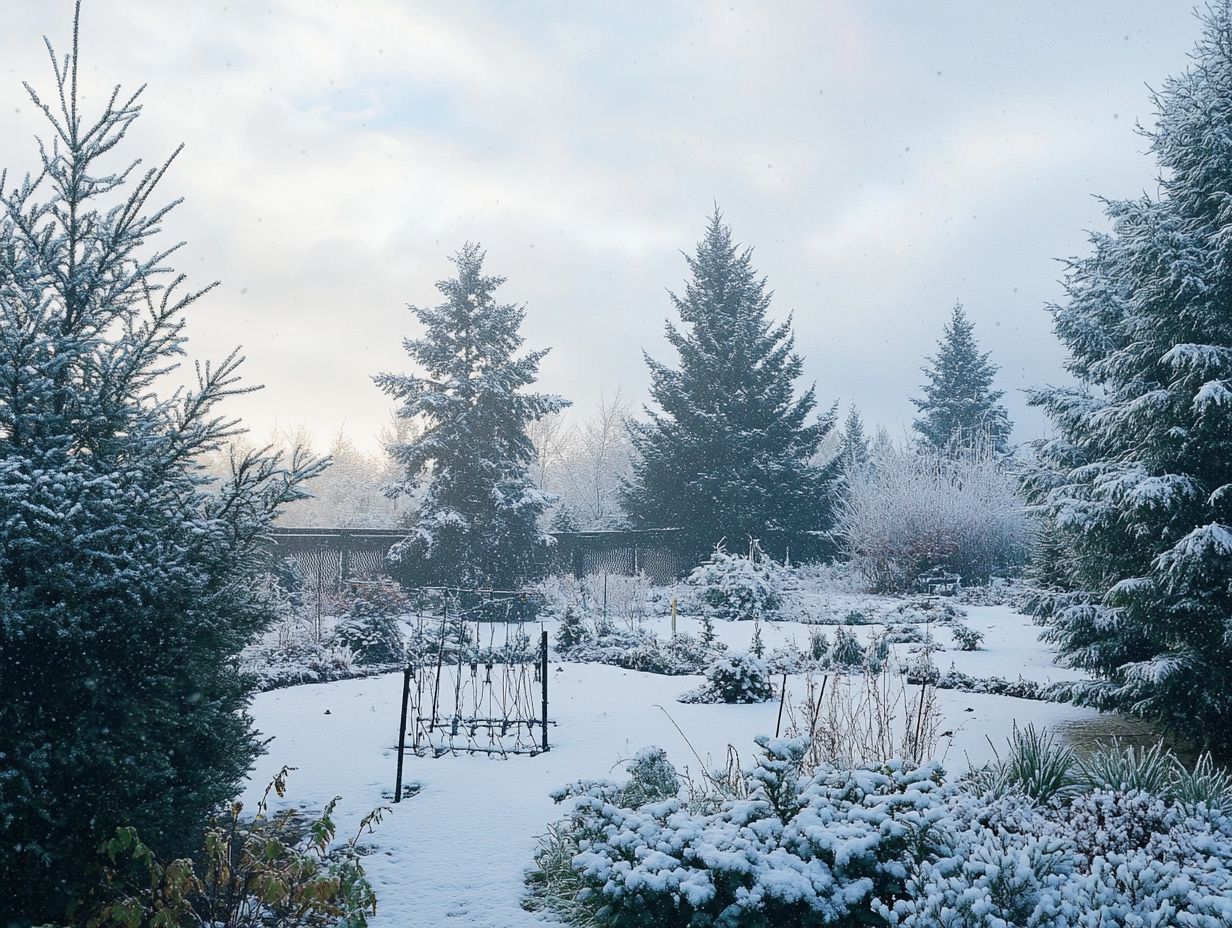
Cold-weather irrigation systems offer many advantages, like saving water, improving energy efficiency, and ensuring reliable performance. This is great news for gardening enthusiasts looking to keep their gardens thriving even in tough climates.
These systems allow for selective watering, which reduces runoff and water waste. They also ensure your plants get the hydration they need without wasting energy.
By automating watering schedules, these systems help maintain moisture levels, which is crucial for preventing winter stress and promoting healthy growth. This provides peace of mind, knowing your garden can flourish even in harsh winter conditions.
What Are the Different Types of Cold-Weather Irrigation Systems?
Cold-weather irrigation systems come in various forms. They use technologies like automatic water removal and freeze prevention to function well in freezing conditions.
These systems are essential for preventing frost damage and keeping your landscape healthy during colder months. For instance, insulated pipe systems work well in regions with extreme temperatures, ensuring smooth water flow.
Underground heating cables are another innovative solution for regulating soil temperature. They are perfect for greenhouses and delicate plants.
By choosing the right system for your environment, you can boost irrigation efficiency and care for your plants, ensuring seamless operation in any weather.
How Can a Business Determine the Best Cold-Weather Irrigation System for Their Needs?
To find the best cold-weather irrigation system, assess your specific needs carefully. Additionally, check out the top 10 must-have tools for winter gardening to ensure reliable performance and customer convenience.
Start by analyzing soil conditions. Knowing your soil type can greatly affect water absorption and distribution.
Next, review your budget to select a system that fits your financial capacity. Water conservation is also key; think about sustainable practices that lower water usage without sacrificing efficiency.
By examining these elements, you can create a strategy that supports your operational goals and shows your commitment to protecting the environment.
What Are the Maintenance Requirements for Cold-Weather Irrigation Systems?
Maintaining your cold-weather irrigation systems is essential for ensuring reliable performance. This requires regular maintenance and troubleshooting.
Inspect key components for wear and tear. Address potential issues before they escalate.
Knowing how temperature changes affect these systems will enable you to take preventative measures, like properly preparing for winter and checking for adequate drainage to avoid freezing.
By conducting regular assessments, you can catch leaks or clogs early. A proactive maintenance approach enhances efficiency and helps you steer clear of costly repairs. This leads to a well-functioning irrigation system throughout the colder months.
What Are the Common Mistakes to Avoid When Using Cold-Weather Irrigation Systems?
Common mistakes with cold-weather irrigation systems can lead to inefficiencies and compromise plant health. Be aware of these pitfalls and implement effective troubleshooting strategies.
One common oversight is inadequate winterization of the system. This can result in freeze damage to pipes and components, ultimately leading to costly repairs.
You might forget to drain the system completely or neglect to insulate vulnerable parts.
Improper scheduling of irrigation can also waste water and fail to provide necessary moisture to your plants, stunting their growth. To avoid these issues, regularly check and adjust your settings according to seasonal changes.
Incorporating a routine maintenance schedule will allow you to catch potential problems before they escalate, enhancing the efficiency of your irrigation system.
Frequently Asked Questions
What are the top 10 cold-weather irrigation systems?
- Sprinkler systems
- Drip irrigation
- Micro-sprinklers
- Rotary nozzles
- Bubblers
- Soaker hoses
- Misting systems
- Subsurface irrigation
- Rainwater harvesting systems
- Smart irrigation systems
What is the most effective cold-weather irrigation system?
The most effective cold-weather irrigation system is a smart irrigation system. These systems use advanced technology to adjust watering schedules based on weather conditions and plant needs, making them essential alongside the top 8 essential watering tools for winter.
Can I use a regular sprinkler system in cold weather, or should I consider a more advanced system?
Yes, a regular sprinkler system can be used in cold weather. However, it is important to properly winterize the system to prevent freezing and damage to the pipes and sprinkler heads.
How do I choose the right cold-weather irrigation system for my garden, considering options like smart irrigation controllers?
To choose the right cold-weather irrigation system for your garden, consider factors such as climate, soil type, plant types, and water availability. It may also be helpful to consult with a professional landscaper or irrigation specialist.
Can I install a cold-weather irrigation system myself, or should I rely on irrigation professionals?
It is possible to install a cold-weather irrigation system yourself. However, it is recommended to hire a professional to ensure proper installation and avoid potential issues or damage.
Are there any eco-friendly cold-weather irrigation systems available, such as drip irrigation and rainwater harvesting systems?
Yes, several eco-friendly cold-weather irrigation systems are available, including drip irrigation and rainwater harvesting systems. These options can help conserve water and reduce environmental impact.
Stay ahead of the game schedule a maintenance check today!



